伊朗山羊群流产的原因及相关风险因素。
IF 2.2
2区 农林科学
Q1 VETERINARY SCIENCES
引用次数: 0
摘要
流产给全球小型反刍动物产业带来了巨大的经济负担,不仅降低了羊群的生产力,还导致了人畜共患病的传播。本研究调查了伊朗 623 个山羊群中与流产(包括感染性和非感染性流产)相关的主要因素。研究采用单变量测试和多变量二元逻辑回归进行统计分析,结合羊群历史、实验室结果进行了综合评估。主要研究结果表明,流产与以前的流产史、流产胎儿的妊娠年龄、兽医例行检查、矿物质补充和疫苗接种等因素有很大关系。非感染因素,如妊娠毒血症、甲状腺肿大和维生素 E/硒 缺乏症,在流产率低的牧群中被发现 (本文章由计算机程序翻译,如有差异,请以英文原文为准。
Causes of abortion in Iranian goat herds and associated risk factors
Abortion imposes a substantial economic burden on the global small ruminant industry, not only reducing herd productivity but also contributing to the spread of zoonotic diseases. This study examines the primary factors associated with abortion, both infectious and non-infectious, in 623 goat herds across Iran. A comprehensive evaluation was performed, incorporating herd history, laboratory results, and statistical analyses using univariate tests and multivariable binary logistic regression. Key findings revealed significant associations with abortion, including previous abortion history, gestational age of the aborted foetus, routine veterinary visits, mineral supplementation, and vaccination practices. Non-infectious factors, such as pregnancy toxemia, goiter, and deficiencies in vitamin E/selenium, were identified in herds with a low abortion prevalence (<10 %). Among the 623 herds studied, 277 (44.5 %) exhibited an abortion prevalence below 2 %, considered within normal limits, while the remaining 346 herds (55.5 %) experienced pathological abortion rates exceeding 2 %. The definitive cause of abortion was determined in 227 of the 346 abortion outbreaks analysed, accounting for 65.6 % of the cases. Infectious agents were identified in 40.7 % of the herds with abortion rates exceeding 2 %, with Brucella melitensis (9.5 %), Chlamydia abortus (7.8 %), and Coxiella burnetii (5.2 %) being the most prevalent pathogens. Multivariable binary logistic regression analysis revealed significant associations between abortion and several factors, including birth (OR=2.01, 95 % CI: 1.05–3.89, P=0.036), previous abortion history (OR=14.5, 95 % CI: 6.01–37.3, P<0.001), gestational age of the aborted foetus (OR=3.07, 95 % CI: 1.63–5.89, P<0.001), routine veterinary visits (OR=0.16, 95 % CI: 0.09–0.27, P<0.001), vaccination (OR=0.25, 95 % CI: 0.11–0.53, P<0.001), and mineral supplementation (OR=0.36, 95 % CI: 0.21–0.62, P<0.001). These findings underscore the diverse causes of abortion in Iranian goat herds, emphasizing the need to improve farmer awareness and access to commercial vaccines targeting infectious abortion agents to enhance herd productivity.
求助全文
通过发布文献求助,成功后即可免费获取论文全文。
去求助
来源期刊

Preventive veterinary medicine
农林科学-兽医学
CiteScore
5.60
自引率
7.70%
发文量
184
审稿时长
3 months
期刊介绍:
Preventive Veterinary Medicine is one of the leading international resources for scientific reports on animal health programs and preventive veterinary medicine. The journal follows the guidelines for standardizing and strengthening the reporting of biomedical research which are available from the CONSORT, MOOSE, PRISMA, REFLECT, STARD, and STROBE statements. The journal focuses on:
Epidemiology of health events relevant to domestic and wild animals;
Economic impacts of epidemic and endemic animal and zoonotic diseases;
Latest methods and approaches in veterinary epidemiology;
Disease and infection control or eradication measures;
The "One Health" concept and the relationships between veterinary medicine, human health, animal-production systems, and the environment;
Development of new techniques in surveillance systems and diagnosis;
Evaluation and control of diseases in animal populations.
 求助内容:
求助内容: 应助结果提醒方式:
应助结果提醒方式:


